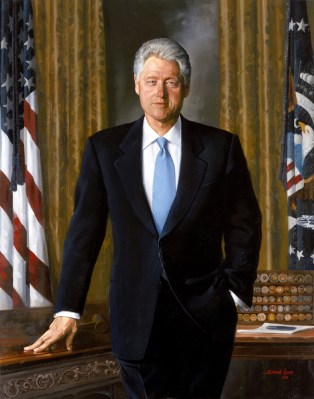
Simmie Knox / Corbis
There isn’t much of a relationship between Barack Obama and George W. Bush, and it is unlikely that Thursday’s unveiling of the former President’s portrait at the White House will alter that dynamic. But if recent history is any guide, personal animosities usually fade away when a sitting President hosts an unveiling for the man he either replaced, defeated or both.
Bush Sr. was moved nearly to tears when Bill Clinton spoke about his “basic integrity and decency” at his unveiling in the East Room in 1995. “Welcome to my hanging,” the elder Bush quipped, gamely trying to lighten the mood. In turn, Clinton was so struck by George W. Bush’s tribute to him in 2004 — and some particularly kind words about Clinton’s mother — that the former President said Bush made him feel like “a pickle stepping into history.” Within days, the two men were telling each other jokes. They have since become friends.
(PHOTOS: 20 Official Presidential Portraits)
The Obama-Bush relationship has been straightforward for years: Obama blames many of the nation’s troubles on the former President while Bush has disappeared from the political scene since leaving office in 2009, saying his successor deserved his “silence.” The two men marked the 10th anniversary of 9/11 in New York City together, but their wives seemed to talk more that day than they did. Bush has performed one or two minor missions at the Administration’s request, but in the main, the two men are not close. It was Obama who asked Bush in January 2009 to get all living former Presidents together for lunch; afterward, Bush said “We want you to succeed.”
This is not Bush’s first return visit to the White House. In January 2010, Obama called on the younger Bush to join with Clinton to lead a national campaign on behalf of Haitian earthquake victims. By contrast, Bush Sr. has been back several times to speak with Obama privately.
However the unveiling goes, there is often some politics in the placement of portraits; where the Bush portrait winds up hanging will be interesting. In an unmistakable sign of tribute, Clinton posted Bush Sr.’s portrait in the Grand Foyer, opposite FDR, and those two men are now remarkably close for men of different parties and generations. Harry Truman showed his gratitude to Herbert Hoover for his help managing European relief by rehanging a portrait of Hoover’s wife Lou in the White House. Dwight D. Eisenhower cared so little for Truman that he removed Truman’s portrait from the public rooms (along with Truman’s piano and favorite chandelier). LBJ moved Ike’s portrait to a more prominent position, so that it would be visible in the background of pictures of Johnson greeting various White House guests. (LBJ was portrait-minded: when he couldn’t sleep, he’d wander the White House with a flashlight, visiting the portrait of Woodrow Wilson, who had been paralyzed by a stroke while in office.) Nixon, following Johnson, put Ike’s portrait in the Cabinet Room. But by then, thanks to the marriage of Nixon’s daughter and Ike’s grandson, the two men were practically related.

